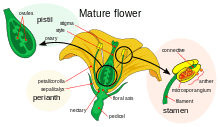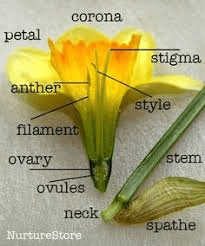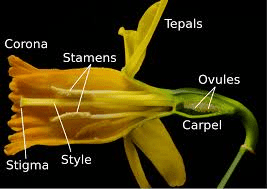The mustard style is an essential part of the female reproductive organ, or pistil, in flowering plants, including mustard plants (genus Brassica). It serves as the connecting tube between the stigma and the ovary, playing a crucial role in the process of fertilization.
In mustard plants, the style is typically a slender, elongated structure that extends from the ovary, which is located at the base of the pistil, up to the stigma, which is the sticky surface at the top of the pistil. The primary function of the style is to facilitate the transfer of pollen from the stigma to the ovary, where fertilization occurs.
During pollination, pollen grains from the stamens (the male reproductive organs) are transferred to the stigma of a mustard flower. The pollen then travels down the style through a channel or tube to reach the ovary. This pathway allows the sperm cells from the pollen to meet the ovules in the ovary, leading to fertilization and the development of seeds.
The length and structure of the style can vary among different mustard species, but it generally needs to be long enough to connect the stigma with the ovary effectively. The style’s length can influence the efficiency of pollen transfer and, consequently, the success of fertilization. In some cases, the style can also affect the positioning of the flowers within the inflorescence, ensuring that they are accessible to pollinators.
After fertilization, the style usually withers and becomes less prominent as the ovary develops into a seed pod, known as a silique, which contains the seeds. The style’s primary role is thus concentrated around the time of fertilization, facilitating the successful reproduction of the plant.
Understanding the style’s function in mustard plants provides insights into their reproductive biology and can inform agricultural practices. For example, research into how different environmental factors affect the style’s development and function can help optimize crop yields and improve breeding programs. Additionally, knowledge of the style’s role can contribute to breeding efforts aimed at developing mustard varieties with desirable traits, such as enhanced flower structure or better seed production.
The style in mustard plants is a vital component of the pistil that connects the stigma to the ovary, facilitating the transfer of pollen and enabling fertilization. Its structure and function are essential for the plant’s reproductive success and have implications for agricultural practices and breeding programs.
The Economic Importance and Uses of Mustard Style

1. Culinary Use: Mustard style refers to the distinctive way mustard is used or presented in cooking, including its variety of forms such as whole seeds, ground powder, and prepared sauces. It enhances the flavor of many dishes and is a staple in cuisines worldwide.
2. Food Preservation: Mustard’s antimicrobial properties make it an effective ingredient in preserving foods. Mustard seeds and powders are used in pickling and preserving processes.
3. Nutritional Supplements: Mustard, in its various styles, is included in dietary supplements for its potential health benefits, including its high antioxidant content and essential nutrients.
4. Culinary Innovation: Mustard style has led to the development of diverse culinary products, including gourmet mustards and specialty sauces, which contribute to the food industry’s growth and innovation.
5. Flavoring Agent: Mustard is used as a key ingredient in many sauces, dressings, and marinades, providing a unique flavor profile that enhances a wide range of dishes.
6. Traditional Medicine: Mustard has been used in traditional medicine for centuries. Its style of use includes topical applications, such as mustard plasters for muscle pain and respiratory issues.
7. Economic Crop: Mustard cultivation contributes significantly to the agricultural economy. Various mustard styles and products provide economic opportunities for farmers and manufacturers.
8. Natural Pesticide: Mustard seeds and extracts are used in natural pest control, leveraging their properties to deter pests in agricultural settings.
9. Skin Care Products: Mustard extracts are used in skincare products for their potential benefits, including anti-inflammatory and antimicrobial effects.
10. Biofuel Production: Research is exploring the use of mustard oil and other by-products in biofuel production as a renewable energy source.
11. Animal Feed: Mustard seeds and by-products are used in animal feed, providing essential nutrients to livestock and improving their diets.
12. Fertilizer: Mustard plant residues, including seeds and stems, are used as green manure and compost to enhance soil fertility.
13. Textile Industry: Mustard seeds are used to produce natural dyes for textiles, adding a sustainable option to fabric coloring.
14. Specialty Foods: Mustard style includes the creation of specialty food products like spicy mustards, mustard-based dressings, and gourmet sauces that cater to diverse consumer preferences.
15. Health Products: Mustard and its derivatives are incorporated into various health products for their antioxidant and anti-inflammatory properties.
16. Research and Development: Mustard style influences ongoing research into new applications and improvements in mustard-based products, including pharmaceuticals and biotechnology.
17. Traditional Crafts: In some cultures, mustard seeds and their by-products are used in traditional crafts and rituals, reflecting their cultural significance.
18. Environmental Benefits: Mustard cultivation supports environmental sustainability by contributing to crop rotation systems and soil health.
Read Also: 22 Medicinal Health Benefits of Garcinia Indica (Kokum)
The Products and By-products That Can Be Derived From Mustard Style

1. Mustard Seeds: Used for cooking, making mustard powder, and extracting mustard oil.
2. Mustard Powder: Ground seeds used in culinary applications and as a component in spice blends.
3. Mustard Oil: Extracted oil used in cooking, skincare products, and as a biofuel.
4. Prepared Mustard: Commercial mustard sauces and condiments made from ground seeds and vinegar.
5. Mustard Seed Extract: Used in supplements and medicinal products for its potential health benefits.
6. Mustard Sauce: Various styles of mustard sauce used in culinary applications, including Dijon, yellow, and spicy mustard.
7. Mustard Paste: Made from ground seeds and liquid, used in cooking and as a condiment.
8. Mustard Dressing: Salad dressings and marinades made with mustard as a key ingredient.
9. Mustard Seed Oil Cake: By-product of oil extraction, used as animal feed and fertilizer.
10. Mustard Seed Flour: Flour made from ground mustard seeds, used in baking and cooking.
11. Mustard Infusion: Infused oils and liquids made from mustard seeds for culinary and medicinal uses.
12. Mustard Skincare Products: Creams, lotions, and soaps made from mustard extracts for skin care.
13. Mustard Compost: Organic compost made from mustard plant residues to enrich soil.
14. Mustard Biofuel: Biofuel produced from mustard oil and plant residues as a renewable energy source.
15. Mustard Seed Dye: Natural dye derived from mustard seeds for textiles and crafts.
16. Mustard Pesticide: Natural pesticide made from mustard extracts to control pests.
17. Mustard Capsules: Dietary supplements containing powdered mustard seeds or extracts.
Read Also: 26 Medicinal Health Benefits Of Baccharis salicifolia (Mulefat)
Frequently Asked Questions (FAQ’s) About Mustard Style

1. What are the health benefits of mustard? Mustard has antioxidant and anti-inflammatory properties, which may support overall health and wellness.
2. How is mustard used in cooking? Mustard is used in various forms, including seeds, powders, and sauces, to enhance the flavor of dishes, dressings, and marinades.
3. Can mustard be used for preserving foods? Yes, mustard’s antimicrobial properties make it effective in food preservation, especially in pickling and canning.
4. Are mustard products safe for pets? Mustard products should be used with caution around pets, as some mustard ingredients can be harmful to animals.
5. How should I store mustard seeds and products? Mustard seeds and products should be stored in a cool, dry place to maintain their quality and effectiveness.
6. What are the different types of mustard? Common types of mustard include yellow (white), brown, and black mustard, each with unique flavors and uses.
7. How do I make homemade mustard? Homemade mustard can be made by grinding mustard seeds and mixing them with liquid like vinegar or water to create a paste or sauce.
8. Can mustard be used as a natural pesticide? Yes, mustard seeds and extracts can be used to create natural pesticides for controlling garden pests.
9. What is mustard oil used for? Mustard oil is used in cooking, skincare products, and as a biofuel, among other applications.
10. How is mustard used in traditional medicine? In traditional medicine, mustard is used for various purposes, including topical applications for muscle pain and respiratory issues.
Read Also: Sa Recycling Process Complete Guide
